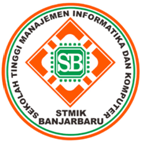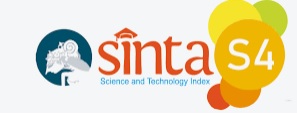Implementasi K-Nearest Neighbor Dalam Memprediksi Keterlambatan Pembayaran Biaya Kuliah Di Perguruan Tinggi
Abstract
The delay in payment of tuition fees at the Muhammadiyah University of East Kalimantan for the 2020/2021 academic year reached 3,018 out of a total of 5,533 students. The number of latecomers is quite large because it exceeds half of the total students. It is deemed necessary to conduct an analysis related to the late payment, so that prevention and treatment can be carried out as early as possible. The purpose of this study is to determine the parameters of delay in paying tuition fees, implementing the K-Nearest Neighbor algorithm, and evaluating the performance of the algorithm using a confusion matrix. The amount of data used for the algorithm performance testing process is 12,408 records with a ratio of 80% training data and 20% testing data. The results of the evaluation test showed that the accuracy of k=3 was 52.82%, k=5 was 52.49%, k=7 was 52.37%, k=9 was 52.33%, and k=11 was 52.53%. The best data test results were obtained at k = 3, namely 52.82%.
Keywords: Accuracy; K-Nearest Neighbor; Tuition Fee Payment, Confusion matrix
Â
Abstrak. Keterlambatan pembayaran biaya kuliah di Universitas Muhammadiyah Kalimantan Timur tahun ajaran 2020/2021 mencapai 3.018 dari total keseluruhan 5.533 mahasiswa. Jumlah yang terlambat tersebut tergolong cukup banyak karena melebihi separuh dari keseluruhan mahasiswa. Dipandang perlu untuk melakukan analisis berkaitan dengan keterlambatan pembayaran tersebut, agar dapat dilakukan pencegahan dan penanganan sedini mungkin. Tujuan penelitian ini adalah menentukan parameter keterlambatan dari pembayaran biaya kuliah, mengimplementasi algoritma K-Nearest Neighbor, dan mengevaluasi kinerja algortima menggunakan Confusion Matrix. Jumlah data yang digunakan untuk proses pengujian kinerja algoritma adalah 12.408 record dengan rasio 80% data training dan 20% data testing. Hasil pengujian evaluasi didapatkan akurasi k=3 sebesar 52,82%, k=5 sebesar 52,49%, k=7 sebesar 52,37%, k=9 sebesar 52,33%, dan k=11 sebesar 52,53%. Hasil pengujian data terbaik didapatkan pada nilai k=3 yaitu 52,82%.
Kata kunci: Akurasi; K-Nearest Neighbor; Pembayaran biaya kuliah, Confusion matrix
References
J. Suntoro, Data Mining Algoritma Dan Implementasi dengan Pemograman PHP. Jakarta: PT Gramedia Jakarta, 2019.
D. W. Farkhina, D. Utari, A.M Siregar, “Implementasi Algoritme K-Nearest Neighboar ( KNN) untuk Prediksi Hasil Produksi,†Sci. Student J. Information, Technol. Sci., vol. 1, no. 1, pp. 21–25, 2020.
E. S. Susanto, K. Kusrini, & H. Al Fatta, “Prediksi Kelulusan Mahasiswa Magister Teknik Informatika Universitas Amikom Yogyakarta Menggunakan Metode K-Nearest Neighbor,†Respati, vol. 13, no. 2, pp. 67–72, 2018.
D. Prasetyawan, R. Gatra, “Algoritma K-Nearest Neighbor untuk Memprediksi Prestasi Mahasiswa Berdasarkan Latar Belakang Pendidikan dan Ekonomi,†JISKA (Jurnal Inform. Sunan Kalijaga), vol. 7, no. 1, pp. 56–67, 2022.
S. R. Rani, S. R. Andani, & D. Suhendro, “Penerapan Algoritma K-Nearest Neighbor untuk Prediksi Kelulusan Siswa pada SMK Anak Bangsa,†Pros. Semin. Nas. Ris. Inf. Sci., vol. 1, pp. 670-676, 2019.
D. Şengür, M. Turban, “Prediction Of The Action Identification Levels Of Teachers Based On Organizational Commitment And Job Satisfaction By Using K-Nearest Neighbors Method,†Fırat Univ. Turkish J. Sci. Technol., vol. 13, no. 2, pp. 61–68, 2018.
A. Alfani, F. Rozi, & F. Sukmana, “Prediksi Penjualan Produk Unilever Menggunakan Metode K-Nearest Neighbor,†JIPI (Jurnal Ilm. Penelit. dan Pembelajaran Inform., vol. 6, no. 1, pp. 155–160, 2021.
J. S. I. Darmayanti, P. Subarkah, & L.R. Anunggilarso, “Prediksi Potensi Siswa Putus Sekolah Akibat Pandemi Covid-19 Menggunakan Algoritme K-Nearest Neighbor,†J. Sains dan Teknol., vol. 10, no. 1, pp. 230–238, 2021.
S. Sukamto, Y. Adriyani, & R. Aulia, “Prediksi Kelompok UKT Mahasiswa Menggunakan Algoritma K-Nearest Neighbor,†JUITA J. Inform., vol. 8, no. 1, pp. 121-130, 2020.
R. K. Dinata, H. Akbar, & N. Hasdyna, “Algoritma K-Nearest Neighbor dengan Euclidean Distance dan Manhattan Distance untuk Klasifikasi Transportasi Bus,†Ilk. J. Ilm., vol. 12, no. 2, pp. 104–111, 2020.
R. W. Abdullah, Kusrini, & E. T. Luthfii, “Prediksi Keterlambatan Pembayaran Spp Sekolah Dengan Metode K-Nearest Neighbor (Studi Kasus Smk Al-Islam Surakarta),†J. Inf. Interaktif, vol. 4, no. 3, pp. 1–18, 2019.
Y. D. Atma, A. Setyanto, “Perbandingan algoritma c4.5 dan k-nn dalam identifikasi mahasiswa berpotensi drop out,†Metik J. ISSN 2580-1503, vol. 2, no. 2, pp. 31–37, 2018.
l Rosiana, “Analisis Kemungkinan Keterlambatan Pembayaran Spp Menggunakan Algoritma Support Vector Machine (Studi Kasus: Smp Perintis …,†vol. 2, no. 9, pp. 1–11, 2020.
M. Muqorobin, K. Kusrini, & E. T. Luthfi, “Optimasi Metode Naive Bayes Dengan Feature Selection Information Gain Untuk Prediksi Keterlambatan Pembayaran Spp Sekolah,†J. Ilm. SINUS, vol. 17, no. 1, pp. 1-14, 2019.
H. Ali, M. N. M. Salleh, R. Saedudin, K. Hussain, & M. F. Mushtaq, “Imbalance class problems in data mining: A review,†Indones. J. Electr. Eng. Comput. Sci., vol. 14, no. 3, pp. 1552–1563, 2019.
W. Widystuti, B. Darmawan. “Pengaruh jumlah data set terhadap akurasi pengenalan dalam deep convolutional networkâ€. Konferensi Nasional Sistem Informasi (KNSI) 2018, pp. 634-638, 2018.
How To Cite This :
Refbacks
- There are currently no refbacks.










